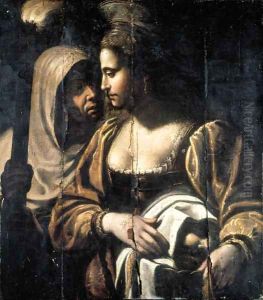Antiveduto Grammatic Paintings
Antiveduto Grammatica (sometimes spelled Grammatic or Gramatica) was an Italian painter of the early Baroque period, born in 1571 in Rome. Not to be confused with his contemporary, the Sienese painter Ventura Salimbeni, who was also known as Antiveduto, Grammatica's work was deeply influenced by the Mannerist style, although he transitioned into the Baroque aesthetic as his career progressed.
Grammatica initially trained under his father, also a painter, before studying under the Mannerist artists Giovanni Domenico Angelini and perhaps with the more famous Santi di Tito in Florence. His style is characterized by his use of chiaroscuro and naturalistic detail, traits that were becoming increasingly popular at the time as the Baroque style began to flourish.
Upon returning to Rome, Grammatica's career rapidly advanced. He received numerous commissions for altarpieces in Roman churches, which was a testament to his growing reputation. His works often featured religious themes, as was common for the time, with an emphasis on dramatic lighting and emotional expression. A notable example of his work from this period is 'The Martyrdom of St. Cecilia,' currently located in the San Carlo ai Catinari church in Rome.
Grammatica's success in Rome also led to his involvement with important artistic circles and patrons. He was one of the founding members of the Accademia di San Luca, an association of artists in Rome that still exists today. This affiliation with the Accademia di San Luca placed him in the midst of the most important artistic debates and developments of his time.
Despite his accomplishments, Grammatica did not leave behind a significant school of followers, and his work was somewhat overshadowed by the towering figures of the Baroque period, such as Caravaggio, with whom he was contemporary. Nevertheless, his paintings are still appreciated for their contribution to the transition from the late Renaissance to the Baroque style.
Grammatica died in 1626 in Rome. His works can be found in various churches in Rome and in art collections specializing in Italian Baroque painting. His legacy is that of a skilled painter who bridged the gap between two significant artistic movements and contributed to the rich tapestry of Italian art history.
